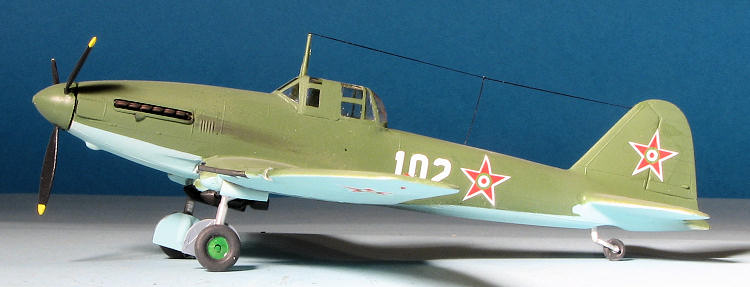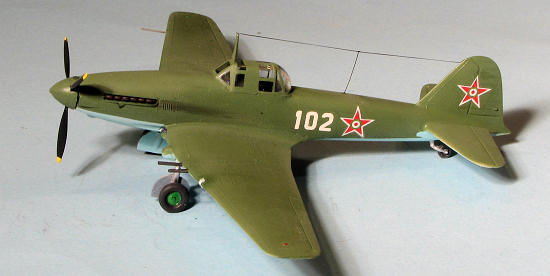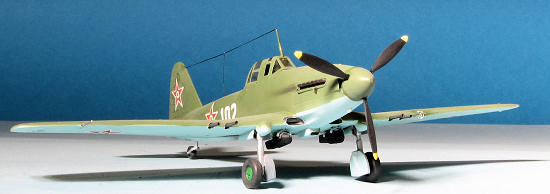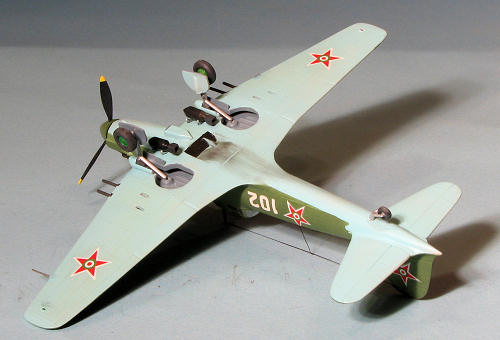
KP 1/72 IL-10/B-33
| KIT #: | 3 |
| PRICE: | $2.00 |
| DECALS: | Three options |
| REVIEWER: | Scott Van Aken |
| NOTES: |

| HISTORY |
Ilyushin Il-10 (Cyrillic Илью́шин Ил-10, NATO reporting name: "Beast") was a Soviet ground attack aircraft developed at the end of World War II by the Ilyushin construction bureau as a replacement for the IL-2. It was also license-built in Czechoslovakia by Avia as the Avia B-33.
In October 1944, the Il-10 first entered service with training
units in the Soviet Air Force. In January 1945, the first Il-10 combat unit
entered service with the 78th Guards Assault Aviation Regiment, but it did not
enter action due to unfinished training. However,
 three other Il-10 units
managed to take part in the final combat actions of World War II in Europe. They
were the 571st Assault Aviation Regiment (from 15 April 1945), the 108th Guards
Assault Aviation Regiment (from 16 April 1945), and the 118th Guards Assault
Aviation Regiment (on 8 May 1945). About a dozen aircraft were destroyed by flak
or engine breakdowns, but the Il-10 appeared to be a successful design. One was
shot down by an Fw 190 fighter, but a crew of the 118th Regiment shot down
another Fw 190 and probably damaged another. On 10 May 1945, the day after the
official Soviet end of the war, (Victory Day), there were 120 serviceable Il-10s
in Soviet Air Force combat units, and 26 disabled ones.
three other Il-10 units
managed to take part in the final combat actions of World War II in Europe. They
were the 571st Assault Aviation Regiment (from 15 April 1945), the 108th Guards
Assault Aviation Regiment (from 16 April 1945), and the 118th Guards Assault
Aviation Regiment (on 8 May 1945). About a dozen aircraft were destroyed by flak
or engine breakdowns, but the Il-10 appeared to be a successful design. One was
shot down by an Fw 190 fighter, but a crew of the 118th Regiment shot down
another Fw 190 and probably damaged another. On 10 May 1945, the day after the
official Soviet end of the war, (Victory Day), there were 120 serviceable Il-10s
in Soviet Air Force combat units, and 26 disabled ones.
After the USSR reentered the war against the Empire of Japan, with the invasion of Manchuria, from 9 August 1945, one Il-10 unit, the 26th Assault Aviation Regiment of the Pacific Navy Aviation, was used in combat in the Korean Peninsula, attacking Japanese ships in Rasin and rail transports.
After the war, until the early 1950s, the Il-10 was a basic
Soviet ground attack aircraft. It was withdrawn from service in 1956. At the
same time, work on new jet-powered dedicated armoured ground attack planes (like
the Il-40) was canceled, and the Soviets turned to multipurpose fighter-bomber
aviation. The Il-10 and its licensed variant, the Avia B-33, became a basic
ground attack plane of the Warsaw Pact countries. From 1949 to 1959, the Polish
Air Force used 120 Il-10s (including 24 UIl-10), and 281 B-33s.
 In Poland, the
B-33 was modified to carry 400 l fuel tanks under its wings. From 1950-60,
Czechoslovakia used 86 Il-10s, including six UIl-10s, and about 600 B-33s. From
1949-56, the Hungarian Air Force used 159 Il-10s and B-33s. From 1950-60, the
Romanian Air Force used 14 Il-10s and 156 B-33s. Bulgaria also used these
aircraft.
In Poland, the
B-33 was modified to carry 400 l fuel tanks under its wings. From 1950-60,
Czechoslovakia used 86 Il-10s, including six UIl-10s, and about 600 B-33s. From
1949-56, the Hungarian Air Force used 159 Il-10s and B-33s. From 1950-60, the
Romanian Air Force used 14 Il-10s and 156 B-33s. Bulgaria also used these
aircraft.
In the late 1940s, 93 Il-10 and UIl-10s were given to North Korea. They were then used in the 57th Assault Aviation Regiment during the early phase of the Korean War. They were initially used with success against the weak anti-aircraft defense of South Korean forces, but then they suffered heavy losses in encounters against the USAAF fighters and were bombed on the ground themselves. After several weeks, about 20 remained. In the summer of 1950, North Korea received more aircraft from the USSR. The North Koreans claimed to sink a warship on 22 August 1950 with Il-10s, but it was never confirmed.
From 1950, Il-10s were used by the People's Republic of China, in two regiments of an assault aviation division. They were used in combat during a conflict with the Republic of China, (Taiwan), over border islands in January 1955. They remained in service until 1972. From 1957, Yemen used 24 B-33s.
| THE KIT |
The IL-10 was the first KP kit that I ever built. Most of the KP kits I have owned have been in a soft white plastic, but it is obvious from this one that other colors were used. This particular one is in a sort of pinkish plastic. General condition of the plastic is quite good so it seems this may well have been an earlier boxing. I say that as I bought this kit in a bag with the fuselage already glued together. Hence the $2 price tag.
 The kit's external detail is all raised panel lines. This is quite typical of KP kits and while many might
shy away from it for that reason, they should not. For one thing, there is not
any other IL-10 injected kit of which I am aware. True, these kits take a bit of
extra work, but I think of them as simply well done short run kits.
The kit's external detail is all raised panel lines. This is quite typical of KP kits and while many might
shy away from it for that reason, they should not. For one thing, there is not
any other IL-10 injected kit of which I am aware. True, these kits take a bit of
extra work, but I think of them as simply well done short run kits.
There is a full interior with an instrument panel, seats for the crew and two crew figures. Though the main gear wells are not boxed in, this is not really that much of a detriment and those who are insistent can resort to plastic card. Gear is fairly well done though a bit simplified. The canopy is nicely molded, but again, not crystal clear. There are horseshoe racks for two medium sized bombs near the fuselage centerline. The gun barrels are simply straight plastic rod and may well be better replaced or at least drilled out.
Instructions are provided in both Czech and in English. A simple exploded view is provided for parts placement. Generic color information is also given. Three markings options for a North Korean, Czech, and Soviet aircraft are provided with all options in dark green over light blue. The decals in my kit are water damaged and unusable so I'll be scouring the spares box for something suitable. Besides, old KP decals are generally rather transparent anyway.
| CONSTRUCTION |
As mentioned, the previous owner had gotten as far as
cementing the fuselage halves together. I took over from here and glued together
the wings after painting the wheel wells in dark grey. I also assembled the
horizontal stabs. Then I glued on the wing. The fit here is pretty atrocious.
While the wing was drying I applied filler to the fuselage seam. The wing to
fuselage join took not
 only quite a bit of gap filling super glue, but a healthy
application of standard filler atop that. I also noticed that I'll have to do
something about the large opening in the back of the wing root cooler intakes.
The landing gear 'knuckles' on the wing leading edge also required quite a bit
of filler and sanding.
only quite a bit of gap filling super glue, but a healthy
application of standard filler atop that. I also noticed that I'll have to do
something about the large opening in the back of the wing root cooler intakes.
The landing gear 'knuckles' on the wing leading edge also required quite a bit
of filler and sanding.
Once that was taken care of, I looked around at some of the other bits. The best thing to do with parts that have alignment pins on them was to remove them. The pins or allegedly corresponding holes were invariably on another plane of existence so removing the pins was the best way to get the parts to match. This included the bombs and the lower oil cooler piece. In fact, I had to put a blob of super glue on the tip of the bombs as they did not match up. This was later sanded to shape.
Next major bit were the tail planes. I'm sure that few would be surprised if I told you the fit was less than sterling. Gap filling super glue to the rescue once again. They were also shorter than the attachment area on the fuselage. With those in place, I attached the canopy. To say it does not fit would be an understatement. The footprint of the canopy attachment area is smaller than the opening in the fuselage to which it fits. Standard glue and a later application of clear gloss paint helped to fill in some of those gaps. I also found when masking that the frame lines were not as easy to see as I had hoped and in the back were basically not there. During this time I also glued on the gear doors.
| COLORS & MARKINGS |
Once that was masked I applied paint. I used White Ensign's WWII USSR paints for the blue on the underside and the dark green upper. I also used their paints for the grey of the wheel wells.
| FINAL CONSTRUCTION |
 The tail wheel and main gear struts were then glued in.
With this done, I gloss coated the areas for the markings. Next were the bomb
racks. As with so many parts, the attachment holes were not very precise and
were far larger than they needed to be. The placement holes for the wing guns
are really just slots. I was not about to use the kit 'guns' (sections of
styrene rod) so cut some stainless tubing. This required the gun holes to be
considerably larger and various sizes of drill bit took care of that. The tubing
was then glued in place.
The tail wheel and main gear struts were then glued in.
With this done, I gloss coated the areas for the markings. Next were the bomb
racks. As with so many parts, the attachment holes were not very precise and
were far larger than they needed to be. The placement holes for the wing guns
are really just slots. I was not about to use the kit 'guns' (sections of
styrene rod) so cut some stainless tubing. This required the gun holes to be
considerably larger and various sizes of drill bit took care of that. The tubing
was then glued in place.
I still had no usable decals so rummaged through the spares box until I found some Bulgarian AF insignia from an old ESCI sheet. This one was special as it was not yellowed. It also featured most of the insignia off register. However, it was more in register on one side than the other so I salvaged six insignia for the kit. Though somewhat transparent, it looks OK on the solid background. For the numbers, I found some of the right size and a font that was close from a KP MiG-21 sheet. These are great decals and even after all the time they have spent in the spares box, were nice and opaque.
 Next to go on
were the wheels. These are supposed to have the ends of the axles 'heat smashed'
to allow the wheels to roll. I installed the wheels and then cut off the
protruding stubs. The large gear doors were then glued in place as was the
forward radio mast. The kit's rear gun is little more than a shape so I was in a
bit of a dilemma as to whether to glue it on or leave it off. I put off that
decision for a bit while I installed the pitot using a section of stainless
steel tubing. Unable to find a replacement, I left the gun out. Next the
bombs were glued in place and I did whatever touch-up painting was needed prior
to giving the model an overall clear matte coat.
Next to go on
were the wheels. These are supposed to have the ends of the axles 'heat smashed'
to allow the wheels to roll. I installed the wheels and then cut off the
protruding stubs. The large gear doors were then glued in place as was the
forward radio mast. The kit's rear gun is little more than a shape so I was in a
bit of a dilemma as to whether to glue it on or leave it off. I put off that
decision for a bit while I installed the pitot using a section of stainless
steel tubing. Unable to find a replacement, I left the gun out. Next the
bombs were glued in place and I did whatever touch-up painting was needed prior
to giving the model an overall clear matte coat.
The last thing was to add a bit of pastel for exhaust and to rig the antenna using EZ-Line.
| CONCLUSIONS |
I have to say that this brought back a ton of memories. Back in the 1970s, this was the first KP kit I had built. Back then, the results were a lot cruder than what they were this time around. The kit very much shows its age and thankfully, KP has gone a long way since then. However, it set me on course to build other similar types of kits, with the B-35 (KP's first plastic kit) coming next. Though by no means a world beater and in desperate need of an updated molding, these kits can frequently be found for a pittance and will help you to stretch those modeling skills that may have gone rusty after a full course of Tamiyas.
| REFERENCES |
http://en.wikipedia.org/wiki/Ilyushin_Il-10
October 2011
Thanks to my penchant for cheap kits on this one.
Copyright ModelingMadness.com. All rights reserved. No reproduction in part or in whole without express permission from the editor.
If you would like your product reviewed fairly and fairly quickly, please contact the editor or see other details in the Note to Contributors.